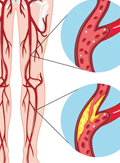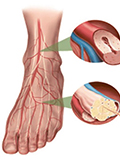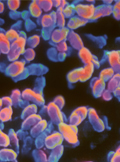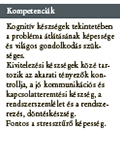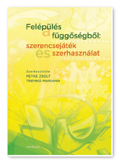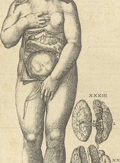The eLitMed.hu medical portal uses computer cookies for convenient operation. Detailed information can be found in the Cookie-policy.
Lege Artis Medicinae - 2019;29(08-09)
Content
[What may hurt the patient’s leg? Lower extremity ischaemia]
[Peripheral artery disease (PAD) is of high prevalence, and one of the most common clinical manifestations of the atherosclerosis beside ischaemic heart disease and cerebrovascular disease. PAD should be considered as a systemic disease, PAD patients have two times higher ten-year cardiovascular mortality than the normal population. For these reasons, the early recognition of the disease, the appropriate secondary preventive medical and non-medical therapy are of great importance. Risk stratification, proper physical examination, ankle pressure, ankle-brachial index, toe pressure, transcutaneous partial tissue oxygen pressure measurement and duplex ultrasound are the cornerstones to an early diagnosis. This summary aims at calling attention to the fact that lower extremity pain can not only be caused by musculosceletal diseases but limb and/or life-threatening limb ischaemia can be revealed in the background. ]
[Hungary’s schizophrenic health policy - solutions under pressure ]
[There are internationally accepted models of health services that succeeded more or less in compromising public and private economy. Unfortunately, Hungary’s health policy was unable since ever to solve this problem. After the fall of the Communist health system (1989) this country was free to implement any means and ways without any external pressure thus only the health policy is responsible for our prevailing circumstances. Additionally, if seen from abroad the well-established medical grease-money of 50-100 thousand million HUF a year in medical services is a surplus burden of socioeconomic corruption. No question, it is necessary to explore any dysfunctions and negotiate with all particular pressure groups, however these actions do not result is system level changes. After 30 years of mismanagement it is time to take over a sound compact model which resembles our traditions and implement while respecting its limits of elasticity. ]
[Treatment of painful diabetic polyneuropathy ]
[Diabetic polyneuropathy can be present in up to 20-60% of diabetics, making it the most common complication of diabetes, but it is often undiagnosed. The diagnosis is mainly based on symptoms, but also several test options are available. For the prevention of neuropathy, long-term control of glycemic parameters is the most important. The pain caused by diabetic polyneuropathy affects 13-26% of diabetics. After the diagnosis, there are a number of treatment options that can be divided into causal and symptomatic therapy. The author summarizes therapeutic options from a practical point of view. ]
[Anti-allergic agents and ICAM-1-antibodies for the control of upper respiratory infections]
[Rhinoviruses are responsible for more than 50 percent of upper respiratory infections. It is well-established that the „Intercellular Adhesion Molecule 1” (ICAM-1) plays a crucial role in the adhesion of rhinoviruses and the relevant secondary bacterial pathogen Haemophilus influenzae to the epithelial cells of the respiratory tract. Both rhinoviruses and H. influenzae enhance the expression of ICAM-1 promoting their own attachment and mutually promoting that of the associated pathogen. It was experimentally shown that anti-ICAM-1 antibodies will inhibit infection by both rhinoviruses and H. influenzae. Since some anti-allergic agents - desloratadine and levocetirizine - also inhibit the expression of ICAM-1, their use may be beneficial in controlling some respiratory infections ]
[Path of life in the society with a diagnosis of a psychiatric disease ]
[INTRODUCTION - The aim of our study is to show how people can live with a diagnosis of a psychiatric disease, a schizophrenia diagnosis in Hungary. METHODOLOGY - We made 25 narrative life story interviews with Hungarian people diagnosed with mental illnesses. We examined what the main obstacles and supporting factors may be in the life stories regarding the independent lifestyle and participation in community. RESULTS - According to the interviewees the main obstacles are their states or diseases, the stigmas after their diagnoses, the function of the psychiatric care system and the lack of self-reliance following the patient role. They mentioned the family and their own motivations as supporting factors. CONCLUSION - The examination of the institutional functions can reveal what the supporting factors may be which can facilitate the social participation of people diagnosed with mental illnesses on the level of the system. ]
[Working capacity assessment: a literature review]
[INTRODUCTION - Although work capacity assessment (WCA) has high social and economical impacts, national medical standards are lacking in Hungary. AIM - The aim of our literature search based review was to gather evidence and international standards on WCA. RESULTS - There are different methods in WCA, from questionnaire forms to computer-based evalution, the latter seems to be the most effective. Apart from physical WCA, additional cardiovascular risk profile and psychoscocial evaluations are recommended. Despite of intesive research of the topic, evidence-based standards do not exist. CONCLUSION - There is an increasing demand on evidence-based WCA. ]
[The health economic ISSUES of geriatric care in Hungary]
[INTRODUCTION - In Hungary, the ageing of the population is a major challenge for the healthcare system (and for the social care). Due to the complexity of treatment of the elderly, geriatric care needs to have a special integrative approach, in order to function effectively. METHODS - We analysed the data that was made publicly available by the Hungarian Payer, together with domestic and international publications, to provide suggestions regarding geriatric care. RESULTS - Based on public data, the utilization of geriatric healthcare services is low, and major differences could be observed within different areas of the country. Within outpatient care, geriatric care shows a decreasing trend. DISCUSSION - It is complicated to navigate through the services provided by the Hungarian healthcare system, while international examples show that additional health gain can be realized with geriatric care. The role of geriatric care needs to be increased within the Hungarian healthcare system, together with addressing the shortage of experts, and clarification of the relations and coordination amongst macro-level systems, and different healthcare professions.]
1.
Clinical Neuroscience
Is there any difference in mortality rates of atrial fibrillation detected before or after ischemic stroke?2.
Clinical Neuroscience
Factors influencing the level of stigma in Parkinson’s disease in western Turkey3.
Clinical Neuroscience
Neuropathic pain and mood disorders in earthquake survivors with peripheral nerve injuries4.
Journal of Nursing Theory and Practice
[Correlations of Sarcopenia, Frailty, Falls and Social Isolation – A Literature Review in the Light of Swedish Statistics]5.
Clinical Neuroscience
[Comparison of pain intensity measurements among patients with low-back pain]1.
Clinical Neuroscience Proceedings
[A Magyar Stroke Társaság XVIII. Kongresszusa és a Magyar Neuroszonológiai Társaság XV. Konferenciája. Absztraktfüzet]2.
3.
Journal of Nursing Theory and Practice
[A selection of the entries submitted to the literary contest "Honorable mission: the joys and challenges of our profession" ]4.
Journal of Nursing Theory and Practice
[End of Life and Palliative Care of Newborns in the Nursing Context]5.
Journal of Nursing Theory and Practice
[Aspects of Occupational Health Nursing for Incurable Patients ]